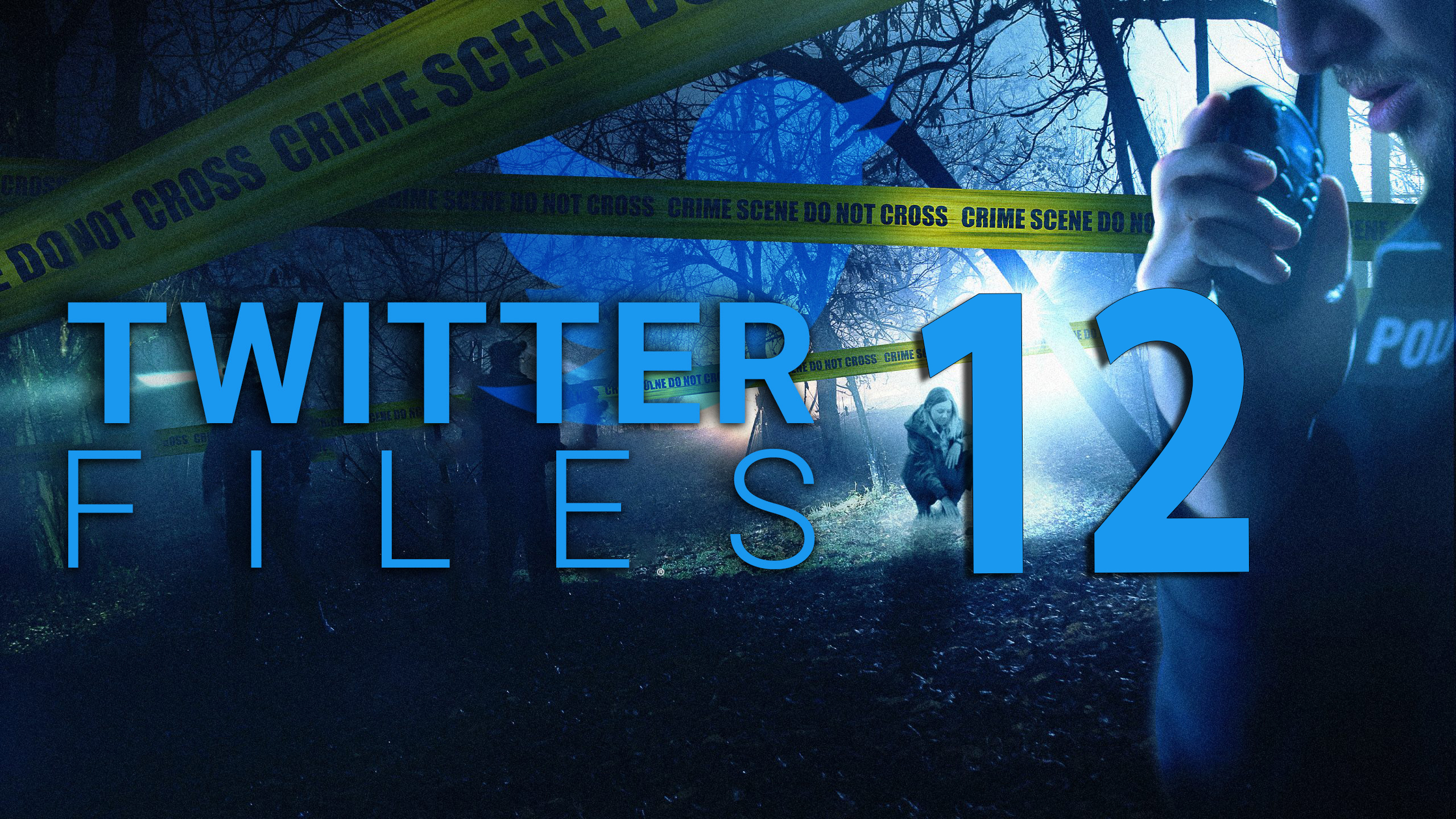The Twitter Files: Part 12 – FBI ‘Belly Button’ Feeds Flood of Govt Influence
First Twitter Files Drop of 2023
While conservatives still await the so-called “Fauci Files,” the 12th edition of the Twitter Files released Tuesday night continued to detail how the FBI became the “conduits” to amass censorship requests to feed through the “belly button” of the social media company.
The past Twitter Files have already called the FBI the “doorman” for myriad government agencies seeking to influence Twitter, but independent journalist Matt Taibbi’s latest edition details how a media pressure campaign caused frustration at Twitter, inundated it with government censorship orders, and forced it to request the FBI to feed requests through a single cord attached at the company “belly button.”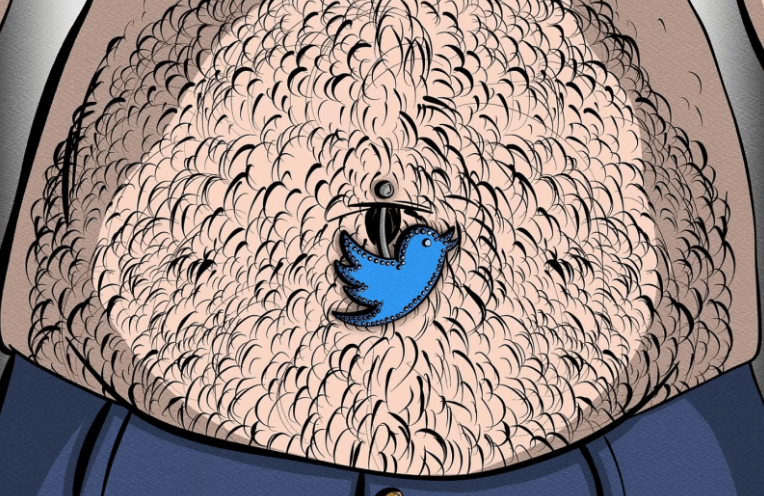
“By 2020, Twitter was struggling with the problem of public and private agencies bypassing them and going straight to the media with lists of suspect accounts,” Taibbi wrote to start his 40-post thread, which started to delve into the COVID-19 pandemic era of Twitter’s release of internal communications.
Former President Donald Trump administration’s State Department started an intelligence group called the Global Engagement Center (GEC) that did not sit well with anti-Trump Trust and Safety chief Yoel Roth, who was also growing frustrated with media reports attacking Twitter for not monitoring COVID-19 narratives.
“Twitter was also trying to reduce the number of agencies with access to Roth,” Taibbi wrote. “‘If these folks are like House Homeland Committee and DHS, once we give them a direct contact with Yoel, they will want to come back to him again and again,’ said policy director Carlos Monje.”
The frustration boiled over at Twitter when the Trump administration sought to decouple social media from accounts tied to the China amid the breakout of COVID-19, which included Canada and CNN accounts.
“When the State Department/GEC – remember this was 2020, during the Trump administration — wanted to publicize a list of 5,500 accounts it claimed would ‘amplify Chinese propaganda and disinformation’ about COVID, Twitter analysts were beside themselves,” according to Taibbi.
“Roth saw GEC’s move as an attempt by the GEC to use intel from other agencies to ‘insert themselves’ into the content moderation club that included Twitter, Facebook, the FBI, DHS, and others,” he continued.
Problems continued when Roth’s hesitancy to accept GEC’s recommendations versus others led to the GEC to further leverage the media to force Twitter’s hand.
But the anti-Trump Roth did not like working with the Trump State Department, effectively choose to cut the GEC out of influencing Twitter’s censorship regime.
“A deeper reason was a perception that unlike the DHS and FBI, which were ‘apolitical,’ as Roth put it, the GEC was ‘political,’ which in Twitter-ese appeared to be partisan code,” Taibbi wrote. “‘I think they thought the FBI was less Trumpy,’ is how one former DOD official put it.”
“After spending years rolling over for Democratic Party requests for ‘action’ on ‘Russia-linked’ accounts, Twitter was suddenly playing tough,” Taibbi continued. “Why? Because, as Roth put it, it would pose ‘major risks’ to bring the GEC in, ‘especially as the election heats up.'”
Amid the fight between government and Twitter, the Roth-comfortable FBI proposed to be the “conduits” to feed the requests through the “belly button” of the private Big Tech company, because Roth wanted a small “circle of trust.”
Once the FBI spigot was fully connected, Twitter became bloated with censorship requests.
“Requests arrived and were escalated from all over: from Treasury, the NSA, virtually every state, the HHS, from the FBI and DHS, and more,” according to Taibbi.
It even ventured into the absurd, as anti-Trump Rep. Adam Schiff, D-Calif., sought to have a journalist he did not like to be banned, Paul Sperry. Twitter responded “we don’t do this,” but ultimately it would relent and ban Sperry anyway.
Eventually, the FBI umbilical cord was fully effective in receiving bans, according to Taibbi.
“They were even warned about publicity surrounding a book by former Ukraine prosecutor Viktor Shokhin, who alleged ‘corruption by the U.S. government’ – specifically by Joe Biden,” Taibbi continued.
Twitter was inundated, and confused, leaving the FBI frustrated it would not get immediate results on censorship requests.
“It all led to the situation described by @ShellenbergerMD two weeks ago, in which Twitter was paid $3,415,323, essentially for being an overwhelmed subcontractor,” Taibbi concluded. “Twitter wasn’t just paid. For the amount of work they did for government, they were underpaid.” source
The Federal Bureau of Investigation (FBI) reportedly promised Twitter it would be “the belly button” for requests from intelligence agencies to the tech industry, newly released documents show.
“Will the industry partners rely on the FBI to be the belly button for the USG? We can do that as well,” FBI Agent Elvis Chan reportedly asked former Twitter Head of Trust and Safety Yoel Roth in an email, according to the latest “Twitter Files” installment reported by journalist Matt Taibbi.
Chan was reportedly asking Roth about monthly calls between intelligence agencies and the tech industry led by the FBI, Taibbi said. Chan was reportedly pushing for the State Department’s Global Engagement Center to be included in the weekly call, according to emails shared by Taibbi.
Twitter reportedly pushed back against including the GEC in the meetings because it was “political” unlike the “apolitical” intelligence agencies. Roth expressed concerns about the GEC being “press happy” and said it would be a “major risk” to bring it into the weekly call, Taibbi reported.
Chan proposed a compromise to Twitter and Facebook where the FBI and Department of Homeland Security (DHS) would serve as “conduits in and out from the USG,” Taibbi continued.
Chan reportedly told Roth, “State/GEC, NSA, and CIA have expressed interest in being allowed on in listen mode only,” on a “one-way” channel with the FBI, DHS, Cybersecurity and Infrastructure Security Agency (CISA) and Office of the Director of National Intelligence (ODNI), Taibbi’s thread showed.
Roth and Chan reportedly ended up agreeing to an industry call on Signal, an encrypted text messaging app, Taibbi added. Twitter reportedly frequently received requests from the FBI, DHS and other intelligence agencies, Taibbi found. The Treasury Department, Health and Human Services, National Security Agency and the State Department were reportedly among the government agencies sending requests to Twitter, according to Taibbi.
The latest installment of the Twitter Files revealed the FBI’s desire for Twitter to rely on it to be the belly button of the U.S. government (USG). The first Twitter Files installment of 2023 revealed shared the events that led up to the intelligence community’s influence on Twitter. Following that installment, journalist Matt Taibbi released another, which revealed the Global Engagement Center’s (GEC) role.
Taibbi described the GEC as “a fledgling analytic/intelligence arms of the State Department,” and screenshots revealed how this new entity would go directly to the media. In one such instance, a report titled, Russian Disinformation Apparatus Taking Advantage of Coronavirus Concerns, was released, which wrecked a bit of havoc for Twitter.
Twitter’s then Trust and Safety head, Yoel Roth, pointed out the motives of Clemson’s Media Forensic Hub when it complained that Twitter hadn’t “made a Russia attribution” in some time.
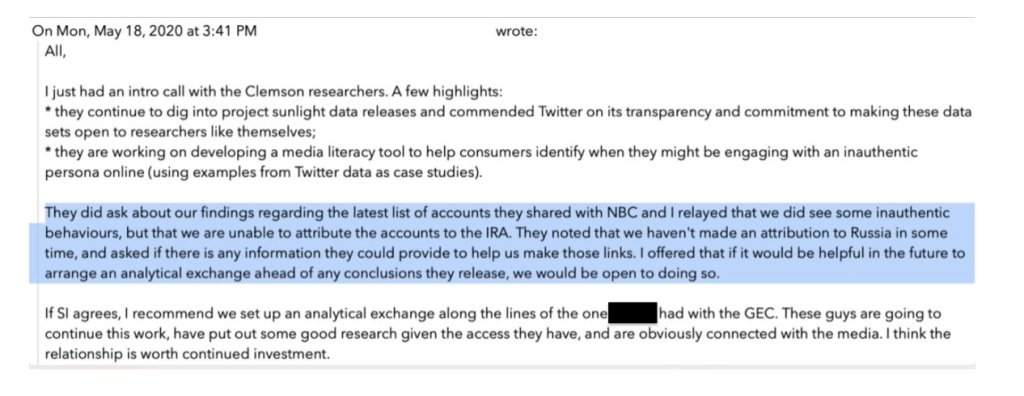
Credit: Matt Taibbi

Credit: Matt Taibbi
Roth told researchers like Clemson that Twitter would be happy to work directly with them instead of the media. He was unsuccessful. Simultaneously, Twitter was trying to reduce the number of agencies that had access to Roth. Twitter’s then-policy director, Carlos Monje, pointed out that once Twitter gave these agencies, such as the Department of Homeland Security, access to Roth.
“If these folks are like House Homeland Committee and DHS, once we give them direct contact with Yoel, they will want to come back to him again and again,” Monje said.
Taibbi noted that the GEC report appeared to be based on DHS data that was circulated earlier that week. The data included accounts that followed two or more Chinese diplomatic accounts and ended up with a list “nearly 250,000” names long. The list included Canadian officials and a CNN account.

Credit: Matt Taibbi
In an email, Roth said that the GEC attempted to insert itself into conversations Twitter had with several government agencies, including the FBI and DHS. The GEC began to agree to loop Twitter in before going public; however, the agency used a technique that trapped Twitter previously.
“The delta between when they share material and when they go to the press continues to be problematic,” a comms official wrote, adding that they primed the media to be “curios and inquisitive of this dynamic, too.”

Credit: Matt Taibbi
This led to Twitter’s disputing a State Department claim that China coordinated coronavirus disinformation accounts. The FBI then informed Twitter that the GEC wanted to be included in their regular “industry call” between companies like Twitter and Facebook and the DHS and FBI. At first, Twitter didn’t want to go this route. Executives at Facebook and Google were united with Twitter in its opposition to the GEC’s inclusion.
“The GEC’s mandate for offensive IO to promote American interests. The relative lack of discretion and caution from senior GEC leadership in sharing reports/analysis based on shaky methodology. A limited track record of successful collaboration with industry.”
Roth noted that an actor such as GEC being introduced to a stable and trusted group of practitioners and experts, especially with the election heating up, posed major risks.
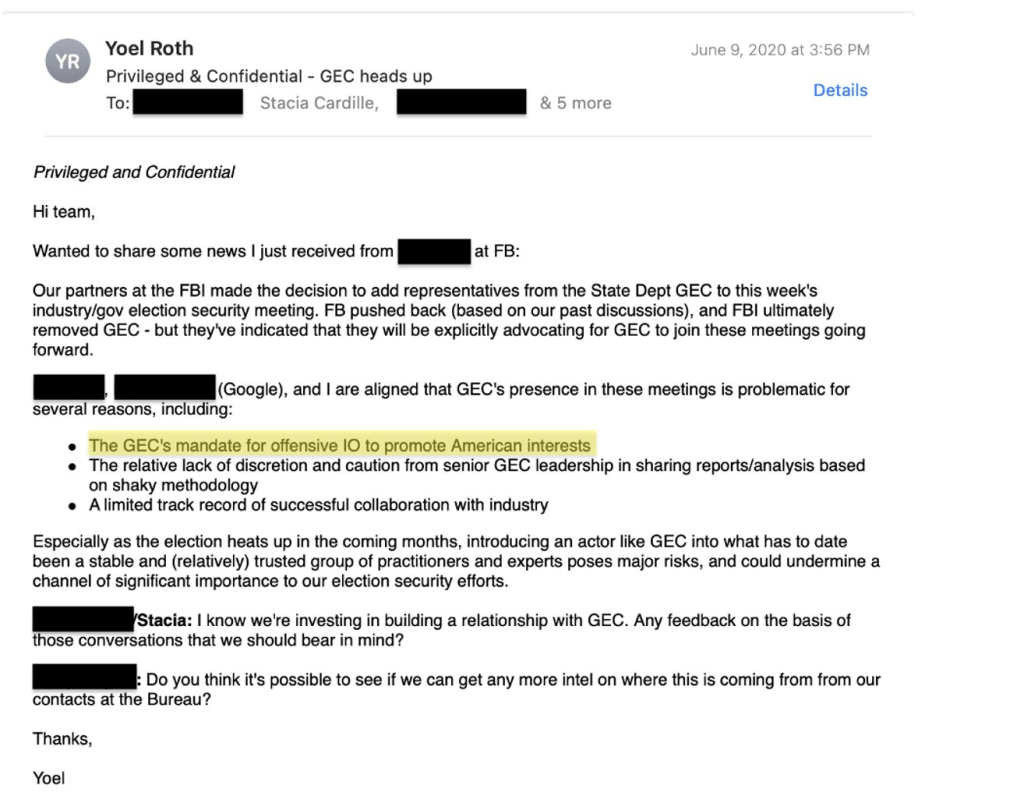
Credit: Matt Taibbi
Roth added that another reason was that the DHS and FBI were “apolitical,” whereas the GEC was “political.”
“GEC has a track record of actively advancing specific ideological agendas (e.g., their work w/r/t Iran). We should not lose sight of this distinction,” Roth wrote.
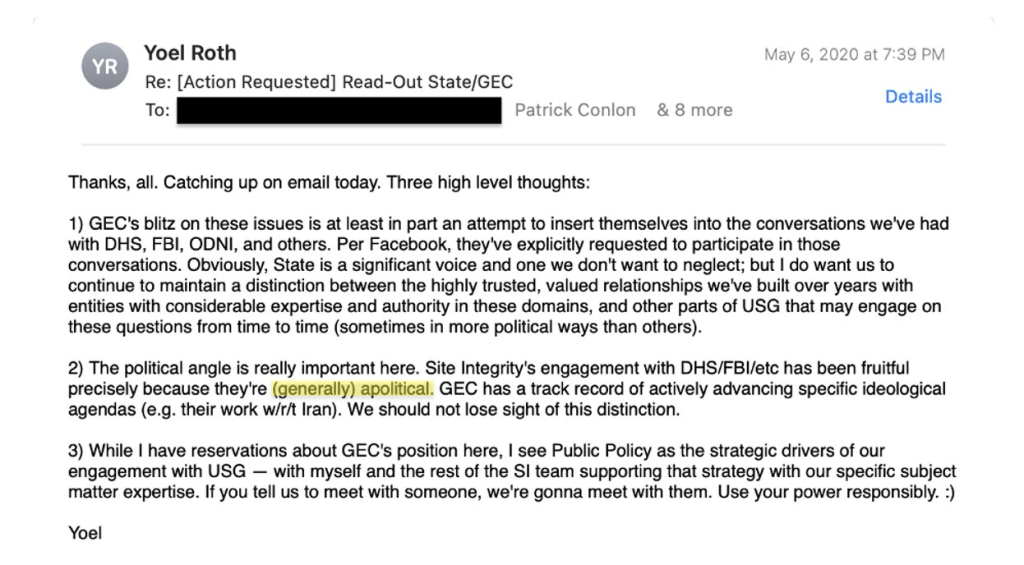
Credit: Matt Taibbi
The FBI argued for a compromise solution that would allow other U.S. government (USG) agencies to participate in the industry calls, with the FBI and DHS acting as sole conduits. When Roth reached out to FBI agent Elvis Chan with concerns, Chan reassured the Twitter executive that it would be a “one-way” channel and “State/GEC, NSA, and CIA have expressed interest in being allowed on in listen mode only.”
“We can give you everything we’re seeing from the FBI and USIC agencies,” Chan told Roth, adding that the DHS agency Cybersecurity and Infrastructure Security Agency (CISA) “will know what’s going on in each state.” Chan then asked if the industry could “rely on the FBI to be the belly button of the USG.”

Credit: Matt Taibbi
The group eventually chose Signal due to its operational security. Following that, Twitter began taking requests from various government bodies starting with the Senate Intel Committee (SSCI), which needed reassurance that Twitter was taking FBI direction.
Twitter also received various requests from officials wanting individuals they didn’t like to be banned from the platform. In the screenshot below, the office for Democrat and House Intel Committee chief Adam Schiff asked Twitter to ban journalist Paul Sperry.

Credit: Matt Taibbi
At the time, Twitter refused. However, Sperry was later suspended. “No, this isn’t feasible/we don’t do this,” Twitter replied.

Twitter honored many of the requests, including those from the GEC, to ban accounts the GEC identified as “GRU-controlled” and linked “to the Russian government.”
A former CIA staffer working at Twitter called the GEC requests “Our window on that is closing,” which meant that the days Twitter could say no to serious requests were over. In the Twitter Files that were released earlier today, Taibbi noted that in public, Twitter would remove content at its “sole discretion.”
Privately, the platform would “off-board” anything that was “identified by the U.S. intelligence community as state-sponsored entity conducting cyber-operations.” That was in 2017. By 2020, agencies were flooding Twitter with “identifications” or users that it wanted Twitter to remove.

Credit: Matt Taibbi
Taibbi pointed out that some reports were only a paragraph long and that Twitter would be forwarded an Excel document without further explanation. Twitter was also warned about the publicity surrounding a book written by former Ukraine prosecutor Viktor Shokhin, who alleged “corruption by the U.S. government” – specifically by Joe Biden.
Screenshots reveal that by mere weeks before the 2020 election, Twitter was so confused by the multiple streams of incoming requests that staffers had to ask the FBI which was which.

Credit: Matt Taibbi
Taibbi noted that this led to the situation described in an earlier Twitter Files release by Michael Shellenberger on December 19, 2022.
In that release, it was revealed that Twitter was paid $3,415,323. Taibbi noted that Twitter wasn’t just paid but underpaid for the amount of work it did for the government. source

